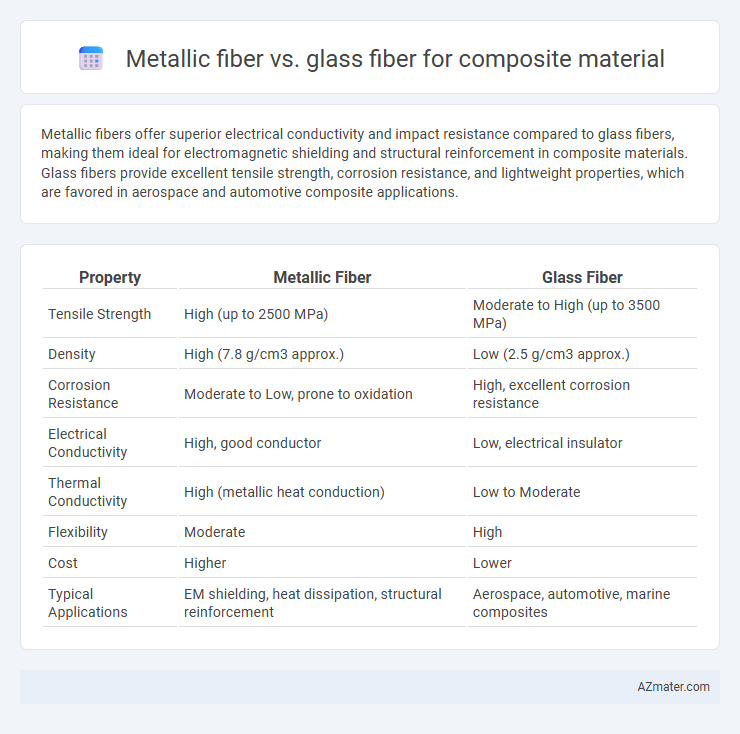Metallic fibers offer superior electrical conductivity and impact resistance compared to glass fibers, making them ideal for electromagnetic shielding and structural reinforcement in composite materials. Glass fibers provide excellent tensile strength, corrosion resistance, and lightweight properties, which are favored in aerospace and automotive composite applications.
Table of Comparison
| Property | Metallic Fiber | Glass Fiber |
|---|---|---|
| Tensile Strength | High (up to 2500 MPa) | Moderate to High (up to 3500 MPa) |
| Density | High (7.8 g/cm3 approx.) | Low (2.5 g/cm3 approx.) |
| Corrosion Resistance | Moderate to Low, prone to oxidation | High, excellent corrosion resistance |
| Electrical Conductivity | High, good conductor | Low, electrical insulator |
| Thermal Conductivity | High (metallic heat conduction) | Low to Moderate |
| Flexibility | Moderate | High |
| Cost | Higher | Lower |
| Typical Applications | EM shielding, heat dissipation, structural reinforcement | Aerospace, automotive, marine composites |
Introduction to Composite Materials
Metallic fibers and glass fibers are critical reinforcements in composite materials, offering distinct mechanical and thermal properties. Metallic fibers provide excellent electrical conductivity, high tensile strength, and enhanced impact resistance, while glass fibers excel in corrosion resistance, high tensile strength, and cost-effectiveness. The choice between metallic and glass fibers depends on specific application requirements such as weight considerations, environmental exposure, and desired mechanical performance in composite structures.
Overview of Metallic Fibers
Metallic fibers, composed primarily of steel, aluminum, and copper alloys, offer exceptional electrical conductivity and high tensile strength, making them ideal for reinforcing composite materials in aerospace and automotive applications. These fibers provide superior impact resistance and enhanced thermal stability compared to glass fibers, enabling composites to withstand extreme environments. Unlike glass fibers, metallic fibers exhibit excellent fatigue resistance and conductivity, contributing to multifunctional composite materials used in electromagnetic interference shielding and structural health monitoring.
Overview of Glass Fibers
Glass fibers, primarily composed of silica, are widely used in composite materials due to their excellent tensile strength, corrosion resistance, and cost-effectiveness. They offer high electrical insulation properties and thermal stability, making them suitable for applications in aerospace, automotive, and construction industries. Their surface chemistry allows for strong bonding with polymer matrices, enhancing mechanical performance and durability of composites.
Mechanical Properties Comparison
Metallic fibers exhibit higher tensile strength and toughness compared to glass fibers, making them more suitable for applications requiring enhanced impact resistance and durability. Glass fibers offer superior stiffness and lower density, contributing to lightweight composites with excellent dimensional stability and corrosion resistance. The choice between metallic and glass fibers for composite materials depends on the specific mechanical property requirements such as strength-to-weight ratio, fatigue resistance, and environmental conditions.
Weight and Density Differences
Metallic fibers typically exhibit higher density values, around 7.8 g/cm3 for steel fibers, compared to glass fibers, which average 2.5 g/cm3, significantly impacting the composite's overall weight. Composites reinforced with glass fibers offer a lightweight advantage, making them preferable for applications where weight reduction is critical, such as aerospace and automotive industries. The lower density of glass fiber composites results in improved fuel efficiency and easier handling, while metallic fiber composites provide superior strength at the expense of increased weight.
Thermal and Electrical Conductivity
Metallic fibers in composite materials offer superior thermal and electrical conductivity compared to glass fibers, which are typically insulating. The high conductivity of metals such as copper or aluminum enhances heat dissipation and electrical performance in composites, making them ideal for applications requiring efficient energy transfer. In contrast, glass fibers provide excellent electrical insulation and thermal resistance but limit conductivity, favoring use in environments requiring minimal heat or electrical flow.
Corrosion and Environmental Resistance
Metallic fibers in composite materials offer superior electrical conductivity but are more prone to corrosion, especially in humid or saline environments, requiring protective coatings or treatments to enhance durability. Glass fibers exhibit excellent corrosion resistance and are highly resistant to chemical and environmental degradation, making them ideal for use in harsh or marine environments. The choice between metallic and glass fibers depends on balancing the need for conductivity against long-term corrosion and environmental resistance demands.
Cost Effectiveness and Availability
Metallic fibers generally offer higher cost effectiveness in specialized applications due to their superior mechanical properties and durability, despite their higher initial price compared to glass fibers. Glass fibers remain more widely available and economically efficient for mass production, benefiting from an established supply chain and lower raw material costs. The choice between metallic and glass fibers depends on balancing performance requirements with budget constraints and material accessibility.
Applications in Industry
Metallic fibers provide superior electrical conductivity and enhanced thermal management, making them ideal for aerospace and automotive components requiring high strength-to-weight ratios and electromagnetic interference shielding. Glass fibers excel in corrosion resistance, tensile strength, and cost-effectiveness, widely used in marine, construction, and wind energy industries where lightweight and durability are critical. Both fibers optimize composite material performance, with metallic fibers favored for advanced electronics and glass fibers dominating structural reinforcement applications.
Future Trends and Innovations
Metallic fibers are gaining traction in composite materials due to their superior electrical conductivity, corrosion resistance, and electromagnetic interference shielding capabilities, driving innovation in aerospace and automotive sectors. Glass fibers continue to dominate with cost-effective, lightweight solutions and high tensile strength, yet recent advancements in nano-engineered glass fibers enhance toughness and fatigue resistance for structural applications. Emerging hybrid composites combining metallic and glass fibers optimize mechanical, thermal, and electrical properties, reflecting future trends in multifunctional, high-performance materials for smart infrastructure and wearable technologies.

Infographic: Metallic fiber vs Glass fiber for Composite material
 azmater.com
azmater.com